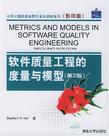软件质量工程的度量与模型
出版时间:2004-7 出版社:清华大学出版社 作者:卡恩 页数:528
Tag标签:无
内容概要
本书主要介绍了软件质量过程的度量与模型,内容包括质量规划、过程提高与质量控制、过程中(in-process)质量管理、产品工程(设计与代码复杂性)、可靠性评估与预测,以及用户满意度数据分析等。本书不仅阐述了有关软件质量的度量与技术知识,还给出了很多的实际案例分析,完全符合软件工程知识体(SWEBOK),具有很好的指导性和实用性。
本书可作为软件工程相关专业高年级学生和研究生的教材,同时也是软件工程专业人员的重要参考书。
书籍目录
Foreword to the Second EditionForeword to the First EditionPrefaceChapter 1:What Is Software Quality? 1.1 Quality:Popular Views 1.2 Quality:Professional Views 1.3 Software Quality 1.4 Total Quality Management 1.5 Summary ReferencesChapter 2:Software Development Process Models 2.1 The Waterfall Development Model 2.2 The Prototyping Approach 2.3 The Spiral Model 2.4 The Iterative Development Process Model 2.5 The Object-Oriented Development Process 2.6 The Cleanroom Methodology 2.7 The Defect Prevention Process 2.8 Process Maturity Framework and Quality Standards 2.9 Summary ReferencesChapter 3:Fundamentals of Measurement Theory 3.1 Definition,Operational Definition,and Measurement 3.2 Level of Measurement 3.3 Some Basic Measures 3.4 Reliability and Validity 3.5 Measurement Errors 3.6 Be Careful with Correlation 3.7 Criteria for Causality 3.8 Summary ReferencesChapter 4:Software Quality Metrics Overview 4.1 Product Quality Metrics 4.2 In-Process Quality Metrics 4.3 Metrics for Software Maintenance 4.4 Examples of Metrics Programs 4.5 Collecting Software Engineering Data 4.6 Summary ReferencesChapter 5:Applying the Seven Basic Quality Tools in Software Development 5.1 Ishikawa's Seven Basic Tools 5.2 Checklist 5.3 Pareto Diagram 5.4 Histogram 5.5 Run Charts 5.6 Scatter Diagram 5.7 Control Chart 5.8 Cause-and-Effect Diagram 5.9 Relations Diagram 5.10 Summary References Chapter 6:Defect Removal Effectiveness 6.1 Literature Review 6.2 A Closer Look at Defect Removal Effectiveness 6.3 Defect Removal Effectiveness and Quality Planning 6.4 Cost Effectiveness of Phase Defect Removal 6.5 Defect Removal Effectiveness and Process Maturity Level 6.6 Summary ReferencesChapter 7:The Rayleigh Model 7.1 Reliability Models 7.2 The Rayleigh Model 7.3 Basic Assumptions 7.4 Implementation 7.5 Reliability and Predictive Validity 7.6 Summary References Chapter 8:Exponential Distribution and Reliability Growth Models 8.1 The Exponential Model 8.2 Reliability Growth Models 8.3 Model Assumptions 8.4 Criteria for Model Evaluation 8.5 Modeling Process 8.6 Test Compression Factor 8.7 Estimating the Distribution of Total Defects over Time 8.8 Summary ReferencesChapter 9:Quality Management Models 9.1 The Rayleigh Model Framework 9.2 The Code Integration Pattern 9.3 The PTR Submodel 9.4 The PTR Arrival/Backlog Projection Model 9.5 Reliability Growth Models 9.6 Criteria for Model Evaluation 9.7 In-Process Metrics and Reports 9.8 Orthogonal Defect Classification 9.9 Summary References Chapter 10:In-Process Metrics for Software Testing 10.1 In-Process Metrics for Software Testing 10.2 In-Process Metrics and Quality Management 10.3 Possible Metrics for Acceptance Testing to Evaluate Vendor-Developed Software 10.4 How Do Your Know Your Product is Good Enough to Ship? 10.5 Summary ReferencesChapter 11:Complexity Metrics and Models 11.1 Lines of Code 11.2 Halstead's Software Science 11.3 Cyclomatic Complexity 11.4 Syntactic Constructs 11.5 Structure Metrics 11.6 An Example of Module Design Metrics in Practice 11.7 Summary ReferencesChapter 12:Metrics and Lessons Learned for Object-Oriented Projects 12.1 Object-Oriented Concepts and Constructs 12.2 Design and complexity Metrics 12.3 Productivity Metrics 12.4 Quality and Quality Management Metrics 12.5 Lessons Learned for OO Projects 12.6 Summary ReferencesChapter 13:Availability Metrics 13.1 Definition and Measurements of System Availability 13.2 Reliability,Availability,and Defect Rate 13.3 Collecting Customer Outage Data for Quality Improvement 13.4 In-Process metrics for Outage and Availability 13.5 Summary ReferencesChapter 14:Measuring and Analyzing Customer Satisfaction 14.1 Customer Satisfaction Surveys 14.2 Analyzing Satisfaction Data 14.3 Satisfaction with Company 14.4 How Good Is Good Enough? 14.5 Summary ReferencesChapter 15:Conducting In-Process Quality Assessments 15.1 The Preparation Phase 15.2 The Evaluation Phase 15.3 The Summarization Phase 15.4 Recommendations and Risk Mitigation 15.5 Summary ReferencesChapter 16:Conducting Software Project Assessments 16.1 Audit and Assessment 16.2 Software Process Maturity Assessment and Software Project Assessment 16.3 Software process Assessment Cycle 16.4 A Proposed Software Project Assessment Method 16.5 Summary ReferencesChapter 17:Dos and Don'ts of Software Process Improvement 17.1 Measuring Process Maturity 17.2 Measuring Process Capability 17.3 Staged versus Continuous-Debating Religion 17.4 Measuring Levels Is Not Enough 17.5 Establishing the Alignment Principle 17.6 Take Time Getting Faster 17.7 Keep It Simple-or Face Decomplexification 17.8 Measuring the Value of Process Improvement 17.9 Measuring Process Adoption 17.10 Measuring Process Compliance 17.11 Celebrate The Journey,Not Just the Destination 17.12 Summary ReferencesChapter 18:Using Function Point Metrics to Measure Software Process Improvement 18.1 Software Process Improvement Sequences 18.2 Process Improvement Economies 18.3 Measuring Process Improvements at Activity Levels 18.4 Summary ReferencesChapter 19:Concluding Remarks 19.1 Data Quality Control 19.2 Getting Started with a Software Metrics Program 19.3 Software Quality Engineering Modeling 19.4 Statistical Process Control in Software Development 19.5 Measurement and the futureReferencesAppendix:A Project Assessment QuestionnaireIndex
图书封面
图书标签Tags
无
评论、评分、阅读与下载
用户评论 (总计0条)
相关图书
- Microsoft.NET框架1.1类库参考手册第3卷
- VHDL 与微机接口设计
- 交换机及其应用技术
- 动态网页设计与电子商务
- 多媒体素材的采集与处理
- 多媒体技术
- 让饮食知识进入你家
- 健康与食物陷阱
- 快速物流
- 《纺织机械噪声测试规范》系列国家标准宣贯教材
- Autodesk Inventor R8机械设计
- 计算机组装维护与维修
- 素质教育新同步(第五册)
- 素质教育新教案 创新练与测 高中语文 第一册 高一上学期
- 素质教育新教案 创新练与测 高中地理上册 高一上学期
- 墨西哥壁画家
- 素质教育新教案 地理
- 清华幼儿英语3b
- 科特勒市场营销教程
- 神居于形
- 我为自己做主
- 破坏游戏(1-3)
- 许麟庐新作
- 孙玉敏作品集
- 当代速写精粹 刘国辉专集
